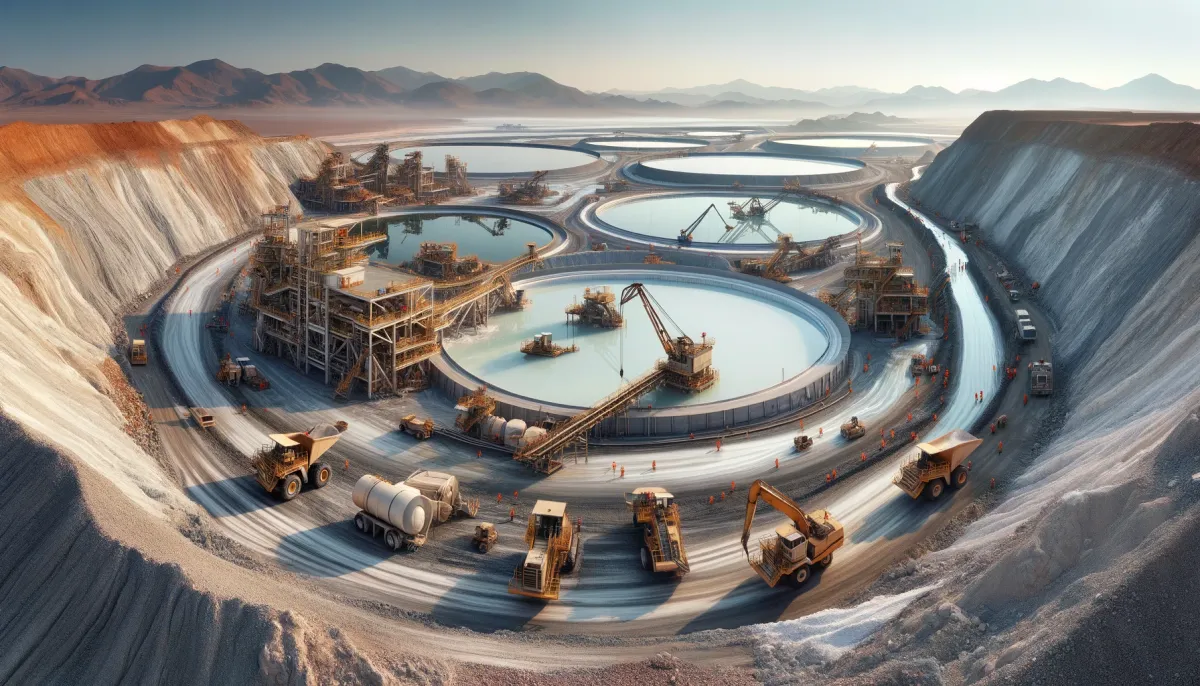Comprehensive Guide to Lithium Production: Importance, Methods, and Global Impact
Lithium revolutionizes technology and energy with vast applications but faces environmental and ethical challenges. Sustainable extraction and ethical practices are vital to mitigate impacts and ensure a balance between innovation and environmental stewardship.

Introduction to Lithium: Essential Element in Technology and Renewable Energy
Lithium, renowned as the lightest metal on the periodic table, is revolutionizing the world of technology and sustainable energy. This essential element is at the heart of the renewable energy revolution, empowering innovations from mobile communication devices to electric vehicles. In this detailed guide, we will unravel the multifaceted dimensions of lithium, shedding light on its critical role in current production methodologies, its extensive applications across various industries, and the notable challenges associated with its extraction and comprehensive utilization.
Lithium's unique properties, such as its exceptional lightness combined with high electrochemical potential, make it an invaluable resource in crafting solutions for modern-day challenges. It plays a critical role in the development of efficient, high-energy-density batteries, enabling advancements in mobile technology and facilitating the global shift toward electric transportation. As we delve deeper into lithium's contributions, we'll explore how this remarkable metal is powering not just devices and vehicles, but also driving significant innovations in renewable energy storage solutions, such as grid batteries, which are essential for harnessing and storing solar and wind energy.
Understanding Lithium: Applications and Natural Occurrence
Lithium, a key element in the advancement of modern technology and renewable energy, is widely recognized for its critical role in the manufacturing of rechargeable batteries. These batteries power a wide array of devices, from smartphones and laptops to electric vehicles (EVs), showcasing lithium's versatility and importance. Beyond battery technology, lithium also finds significant applications in aerospace alloys, enhancing the performance and durability of aircraft materials. In the production of glass and ceramics, lithium contributes to improved thermal and chemical resistance, making products more durable and efficient. Furthermore, in the field of psychiatry, lithium acts as an essential stabilizer, helping to manage mood disorders and contributing to mental health treatments.
The natural occurrence of lithium is primarily within the Earth's crust, sourced from mineral deposits and brine pools. However, extracting lithium from these natural resources demands advanced technological processes. The metal's unique chemical properties, such as its high reactivity and low density, make its extraction a complex and sophisticated endeavor, highlighting the need for innovative solutions in lithium mining and processing.
Exploring Lithium Production Techniques
The production of lithium employs two primary methods: hard rock mining and brine pool extraction. In hard rock mining, lithium-bearing minerals, such as spodumene, are extracted from solid rock formations. This process involves traditional mining techniques but requires additional steps to separate the lithium from other minerals due to its chemical properties. On the other hand, brine pool extraction represents a different set of challenges and techniques. In this method, lithium is extracted from underground pools of salty water. The brine is pumped to the surface and left to evaporate in large ponds, a process that can take several months. Following evaporation, the concentrated lithium is chemically separated from the remaining salts. Both approaches to lithium production underline the technological sophistication and environmental considerations inherent in extracting this valuable element.
Global Lithium Supply and Demand Dynamics
The global demand for lithium has surged, primarily driven by the booming battery industry and the increasing popularity of lithium-ion batteries in electric vehicles (EVs). This growing demand places a spotlight on the current state of lithium supply and highlights the increasing consumption rates worldwide. As we delve into the dynamics of global lithium supply and demand, this segment examines how the industry is responding to the escalating need for lithium. Factors such as mining capacities, geopolitical influences, and technological advancements in battery production are pivotal in understanding the critical balance between supply and demand. With the world leaning more towards sustainable and clean energy solutions, the demand for lithium is projected to rise even further, making the exploration of efficient production methods and sustainable mining practices more important than ever in maintaining a balance between our technological ambitions and the health of our planet.
Leading Lithium-Producing Nations
The largest lithium-producing nations, listed in order of their production quantities from highest to lowest, typically are:
- Australia - Leading the world in lithium production, Australia mines most of its lithium from hard rock sources, primarily from the Greenbushes spodumene mine.
- Chile - Chile is the second-largest producer of lithium and leads in lithium brine extraction from the Atacama Salt Flat.
- China - Ranking third, China produces lithium from both hard rock and brine sources.
- Argentina - Another significant player in the lithium market, Argentina produces lithium mainly from brine sources.
- Zimbabwe - While not as prominent as the other countries on this list, Zimbabwe is significant for its production of lithium from hard rock mining.
Note that the exact rankings can vary year by year based on actual production figures, exploration successes, and market demands. However, these countries have consistently been at the forefront of lithium production globally.
Major Lithium Production Companies Worldwide
The largest lithium-producing companies, typically listed in order of their production capacity from highest to lowest, include:
- Jiangxi Ganfeng Lithium Co., Ltd. - A Chinese lithium company, Ganfeng is one of the world's largest and most significant lithium manufacturers, involved in lithium mining, refining, and battery manufacturing.
- Albemarle Corporation - Based in the United States, Albemarle is a global leader in the production of lithium and lithium compounds and has operations in multiple countries.
- Sociedad Química y Minera (SQM) - A Chilean chemical company, SQM is one of the world's largest lithium producers, extracting lithium from the Atacama Salt Flat in Chile.
- Tianqi Lithium - This is a leading Chinese lithium producer with significant interests in the Greenbushes lithium mine in Australia, among other ventures.
- Livent Corporation - Formerly part of FMC Corporation, Livent is a US-based company with lithium operations in Argentina and other countries.
These rankings can vary based on the latest market data and company performances. The lithium market is dynamic, with production capacities and rankings changing as companies expand their operations and new players enter the market.
The application and usage of Lithium
Lithium Batteries: Revolutionizing Energy Storage
Lithium is the top choice for batteries due to its high energy density, enabling longer usage without significant weight. Lithium-ion batteries are widespread, offering efficiency for portable electronics and EVs. Lithium-polymer variants provide flexible, lightweight options for modern devices, while lithium iron phosphate batteries are valued for safety and longevity, ideal for stationary storage and safe EV applications. The selection between types hinges on device requirements and safety priorities.
Diverse Applications of Lithium
Lithium's versatility extends far beyond the realm of battery technology, touching various sectors that capitalize on its unique properties. In the aerospace industry, lithium is prized for its lightweight yet strong characteristics, enhancing fuel efficiency and performance in aircraft and spacecraft. The addition of lithium to glass and ceramics results in stronger, more durable products, with improved thermal resistance, making them ideal for more robust and efficient cookware, tiles, and other household items.
Moreover, lithium compounds are used as high-temperature lubricants due to their ability to withstand extreme conditions without breaking down, ensuring the smooth operation of heavy machinery and vehicles under high stress and temperature. This broad spectrum of uses underscores lithium's critical role in not only powering cleaner energy solutions, like electric vehicles, but also in advancing manufacturing processes and product functionalities across different industries. The diversity of its applications highlights the global reliance on this element for advancements in technology and sustainability.
The Environmental and Ethical Challenges of Lithium
Lithium mining poses environmental challenges, including water scarcity, soil contamination, and ecosystem disruption, particularly in areas like the Atacama Desert where extraction significantly impacts water resources and local wildlife. These environmental concerns highlight the necessity for sustainable mining practices that prioritize water conservation, reduce chemical pollution, and protect natural habitats to mitigate the ecological footprint of lithium extraction.
Moreover, ethical dilemmas arise from lithium mining, such as poor working conditions and the negative impact on indigenous communities living near extraction sites. Addressing these issues requires implementing fair labor practices, ensuring community consent and benefit-sharing, and promoting transparency. Additionally, advancing lithium recycling technologies can lessen the need for primary mining, lower environmental impacts, and support a more sustainable lithium industry.
Conclusion: Balancing Lithium's Benefits with Environmental Responsibilities
In conclusion, lithium serves as a cornerstone element, driving the advancement of technology and sustainable energy with its unique properties and wide-ranging applications. From revolutionizing the battery industry and enhancing aerospace alloys to improving the durability of glass and ceramics, lithium's role is indispensable in shaping a more sustainable and technologically advanced future. However, the journey toward harnessing lithium's full potential is not without its challenges. The environmental and ethical issues surrounding lithium mining necessitate a concerted effort toward sustainable extraction practices, responsible resource management, and the development of effective recycling technologies. As we move forward, balancing technological progress with environmental stewardship and ethical considerations will be paramount in ensuring that lithium continues to power our world in a manner that is both innovative and conscientious.




